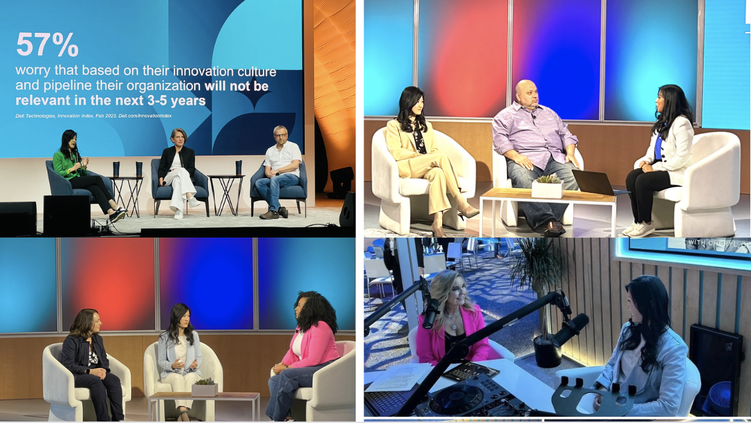Comments
- No comments found

Innovation, a word that rolls off the tongue effortlessly, yet achieving it successfully and consistently can be an arduous endeavor.
We all aspire to innovate, to create something extraordinary, to push the boundaries of what is possible. And yet, the road to innovation is riddled with challenges and uncertainties.
Dell Technologies, recognizing the significance of innovation in shaping out future, conducted a global benchmark study, the innovation index. Its findings were both eye-opening and thought-provoking. Astonishingly, 57% of respondents expressed concerns that their organizations, with their current innovation culture and pipeline, may become irrelevant within the next 3-5 years. Additionally, 64% acknowledged that certain aspects of their company’s culture were hindering their innovation potential.
These statistics paint a stark picture, one that demands our attention and action. The truth is, in this rapidly changing landscape, innovation is not a mere luxury, it is an imperative. It is the driving force that propels organizations forward, enabling them to adapt, thrive, and remain relevant amidst constant disruption.
But what does it truly mean to innovate? It goes beyond launching new products or services and hoping for success. It involved fostering a culture that values experimentation, learning from failure and embracing the unknown. Innovation is a mindset, a way of thinking that permeates every aspect of an organization, from its leadership to its employees.
To delve deeper into the topic of driving innovation culture, I had the privilege of hosting two remarkable experts at Dell Tech World. Tim Bicio the visionary CTO of Lightstorm Entertainment, and Jen Felch, Dell Technologies’s esteemed Chief Digital Officer and CIO, graced us with their invaluable insights.

We explored the pivotal role that tech leaders play in shaping an innovation culture, one that nurtures the right skills and mindsets within their teams. Jen eloquently expressed the significance of tech leaders’ involvement from the beginning, working in collaboration with HR leaders and engaging employees transparently. Culture, she emphasized, sets the norms and behanviors within a team, and it is the responsibility of leaders to drive and cultivate it.
Tim Bicio, drawing from his experience of pushing boundaries in the entertainment industry, shared his perspectives on bridging generational mindsets, strengthening skill sets, and empowering teams in the hybrid work environment. His insights were both inspiring and enlightening, reminding us that innovation knows no boundaries and that nurturing an innovation culture can be a competitive advantage.
The conversations then led us to explore how technology can empower our workforce to work and innovate from anywhere. Jen shared her wisdom on balancing the act of pushing boundaries while ensuring productivity and security. She discussed the Importance of personalization, unified management across devices, and secure access to network and data.
Burzin Engineer, the Co-Founder and Chief Reliability Officer of PhonePe, joined me in a fireside chat on sustainable data centers. We uncovered the transformative potential of sustainable innovation, aligning eithical principles with long-term value for both businesses and the planet. Burzin shared how PhonePe has prioritized sustainability in its data centers, embracing alternative cooling technologies and reaping tangible benefits.
In addition, Jaynene Hapanowicz, Dell Technologies’s CTO and SVP of Technology Transformation and I engaged in a powerful digital broadcast about the future of work. We explored the tremendous strides made in working from everywhere, the importance of maintain momentums, and the need to keep pushing forward. This entails developing a deliberate strategy that tailored to your needs, and providing people reliable and secure connectivity to be productive, innovative driving sustainable success working from everywhere. According to Dell’s Innovation Index, ITDMs are struggling in some areas such as providing technology for individual needs and preferences, ensuring secure remote work for their employees. Organizations should start with a human-centered approach and involve their employees when designing the future of work strategy. To drive productivity and creativity, IT leaders should focus on providing more intelligent and responsive technology to improve the work experience. This can be achieved by understanding pain points, user expectations, and designing a technology roadmap together with the business. Deploying technologies with proper training and support is crucial, considering digital fluency and technical skills. The audience can start today by empowering their people to make decisions about where they work based on their needs, which will spark creativity and foster innovation.
Lastly, I enjoyed being featured on The Partner Connection Podcast, hosted by Cheryl Cook, SVP of Global Partner Marketing at Dell Technologies. We explored "Lessons learned from Dell Innovation Index and how to accelerate innovation". Here are a ew highlights of the learnings:
Perception gap: while an overwhelming 71% of the organizations regard themselves as innovative or extremely innovative, only a mere 18% can truly be classified as innovative. This perception gap is concerning and highlights the need for self-reflection and improvement.
Relevancy: 57% of organization worry that their current innovation culture and pipeline might render them irrelevant in 3-5 years.
Accelerating growth: during times of turbulence and economic uncertainty, innovation leaders and adopters are 2.2 times more likely to accelerate growth, gaining a substantial competitive advantage. This statistic showcases the tangible benefits that organizations reap when they prioritize innovation.
Cheryl then steered the conversation towards the question of what leaders do well and how we can learn from them. I addressed this from people, process, and technology perspectives:
Innovation becomes a talent magnet, attracting skilled individuals to their teams. By fostering an innovation culture that encourages learning from failure and empowers everyone to contribute their ideas, they create an environment where innovation thrives. Forward-looking leaders collaborate with external partners to identify trends, forecast future needs, and bridge skill gaps.
Dell Innovation Index uncovered some concerning insights. Only 52% organizations align innovation initiatives to company goals, while a mere 26% base their innovation decisions on data. However, the innovation leaders take a holistic approach, securing stakeholders buy-in and employee involvement through consistent communication, running pilots to demonstrate proof of concept, and hosting hackathons or scrums to foster innovation and collaborative problem-solving.
Future-ready leaders recognize the strong correlations between technology maturity, intention, and successful innovation. Challenges such as the speed of tech advances and resulting complexity can hinder organizations, with 57% expressing concern that their technology is not cutting-edge. However, leaders invest in modern, scalable technologies and nurture the partnership between IT and business to increase tech and innovation maturity.
Let us not forget that building a strong innovation practice does not mean resting on our laurels. The world is in a constant state of change, and leaders must continuously adjust across people, processes, and technology.
The path to innovation may be challenging and uncertain, but it is through embracing innovation that we can accelerate change and propel ourselves forward. It is evident that organizations must prioritize innovation to remain relevant in the ever-evolving landscape. Innovation goes beyond the launch of new products or services; it requires a cultural shift that values experimentation, embraces failure as a learning opportunity, and empowers every individual within an organization.
I have been fortunate to play an active part at Dell Tech World, hearing from visionary leaders who have shared their experiences and perspectives on driving innovation culture. They have reminded us that innovation knows no boundaries and that fostering an environment that nurtures creativity and empowers teams is a competitive advantage.
Innovation is not a destination, but a continuous journey. It requires constant adaptation and adjustment across people, process, and technology. By embracing innovation, we have the power to shape a brighter future, overcome challenges, and unlock limitless possibilities.
Helen Yu is a Global Top 20 thought leader in 10 categories, including digital transformation, artificial intelligence, cloud computing, cybersecurity, internet of things and marketing. She is a Board Director, Fortune 500 Advisor, WSJ Best Selling & Award Winning Author, Keynote Speaker, Top 50 Women in Tech and IBM Top 10 Global Thought Leader in Digital Transformation. She is also the Founder & CEO of Tigon Advisory, a CXO-as-a-Service growth accelerator, which multiplies growth opportunities from startups to large enterprises. Helen collaborated with prestigious organizations including Intel, VMware, Salesforce, Cisco, Qualcomm, AT&T, IBM, Microsoft and Vodafone. She is also the author of Ascend Your Start-Up.
Leave your comments
Post comment as a guest